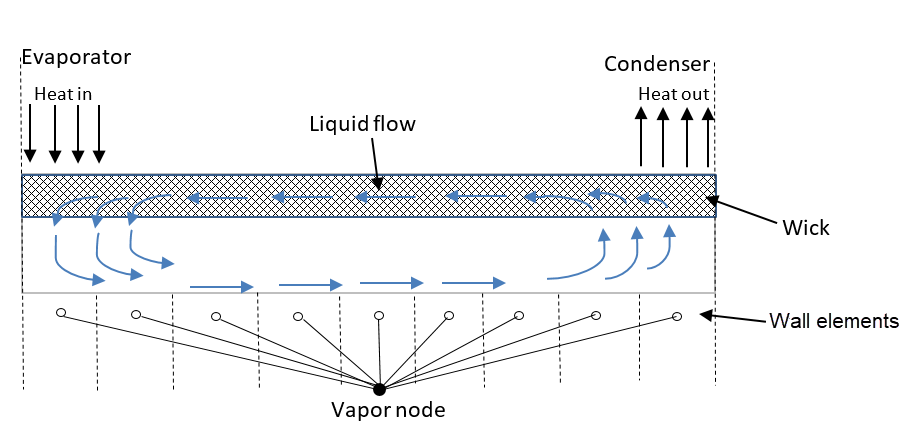Heat pipe modeling
Heat pipes transfer heat through the length of a heat pipe, from the evaporator to the condenser, by phase changing a working fluid. The condensed fluid is pumped back to the evaporator by the capillary force in the wick structure.

The thermal solver models a heat pipe as a set of conductances from the heat pipe evaporator and condenser wall elements to a vapor node. The vapor node is an internally created non-geometric element, one per heat pipe, which represents the calculation point of the heat pipe fluid temperature. The wall elements are elements that are connected to the heat pipe external walls.
Each conductance represents the combined effects of evaporation and condensation and thermal conduction in the heat pipe walls and wick near the specific element.
The thermal solver computes the vapor node temperature so that the heat that comes to the vapor node from evaporator elements is balanced by the heat that goes from the vapor node to the condenser elements. The thermal solver determines which elements of the heat pipe are the condenser or evaporator depending on the temperatures that are above or below the vapor temperature, respectively.
The thermal solver determines which conductance is used for each heat pipe wall element in a given nonlinear thermal solve iteration, depending on whether the element is an evaporator or condenser element. It also depends on the wall element area for 3D models or length for 2D models.
The solver computes the heat pipe conductances based on multiple input options.
- Defined overall conductance G
- In this case, the thermal solver computes the heat pipe conductances so that the overall heat flow from the evaporator to condenser equals G times the difference between overall area-weighted average of evaporator temperatures, and the similar average of the condenser temperatures. Thus, the heat flow is distributed between the condenser (or evaporator) elements in proportion to their elemental areas. That overall conductance G may also be temperature dependent. The temperature value used for that dependence is the vapor node temperature.
- Defined evaporation and condensation heat transfer coefficients for each heat pipe element
- In this case, the thermal solver determines the heat pipe conductances by the corresponding the heat transfer coefficient for the current element role, such as evaporator or condenser and the wall element area. If the heat transfer coefficients are temperature dependent, then the solver uses their corresponding wall element temperatures for their evaluation.
- Defined maximum heat flow
- In this case, the thermal solver downscales the heat pipe conductances as necessary so that the overall heat flow from the evaporator and condenser does not exceed the specified maximum heat flow, which can be temperature dependent. The temperature value used for that dependence is the vapor node temperature.
- Defined heat pipe temperature range
- In this case, the thermal solver nullifies the heat pipe conductances when the vapor node temperature is outside of the minimum and maximum limits.
